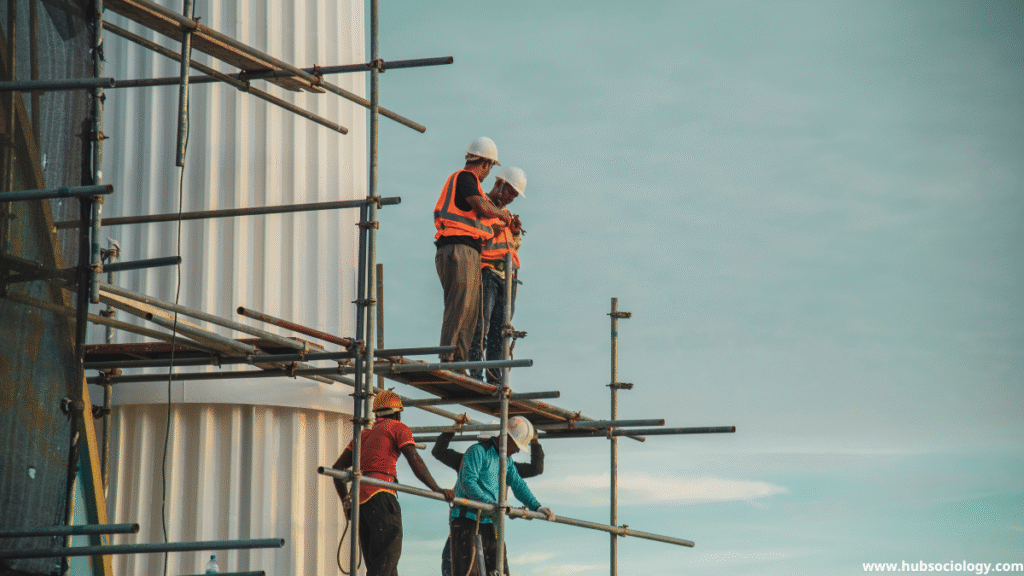Introduction
Labor migration has become one of the most defining social, economic, and cultural phenomena in Central Asia since the collapse of the Soviet Union. Russia, as the largest economy in the post-Soviet space, has attracted millions of migrant workers from Central Asian republics such as Uzbekistan, Tajikistan, Kyrgyzstan, Kazakhstan, and Turkmenistan. While Russia’s growing demand for cheap labor, especially in construction, agriculture, and low-wage services, acts as a pull factor, poverty, unemployment, and limited economic opportunities in Central Asia serve as strong push factors.
From a sociological perspective, labor migration between Central Asia and Russia is not merely an economic exchange but a complex process reshaping family structures, community dynamics, gender roles, cultural identities, and state-society relations. Migration creates both opportunities and vulnerabilities, integrating societies while also producing new forms of dependency, inequality, and marginalization.
This article examines the sociological dimensions of Central Asian labor migration to Russia, its impact on sending societies, and its broader implications for social change in the region.

Table of Contents
Historical Background of Labor Migration to Russia
During the Soviet period, labor mobility across republics was centrally managed, with workers moving for industrial, agricultural, or administrative assignments. After the dissolution of the Soviet Union in 1991, Central Asian republics faced economic collapse, unemployment, and population pressures. At the same time, Russia experienced demographic decline, labor shortages, and economic growth in the early 2000s due to high oil and gas revenues. This complementary situation gave rise to massive labor migration flows.
By the 2010s, an estimated 10–12 million migrant workers were in Russia, with the majority from Uzbekistan, Tajikistan, and Kyrgyzstan. For countries like Tajikistan, remittances from migrants formed nearly 30–40% of GDP, making migration a lifeline for entire societies. This structural dependency created a new social order, where migration is no longer temporary but deeply embedded in the life strategies of households and communities.
Sociological Aspects of Labor Migration
1. Economic Survival and Family Dynamics
Migration is often seen as a survival strategy. Families in Central Asia rely heavily on remittances to meet basic needs such as food, housing, healthcare, and education. In rural areas, migration has replaced agriculture as the main source of livelihood.
- Remittances and Social Status: Households with migrant members often enjoy higher social prestige due to improved material conditions. This creates new forms of social stratification within villages, where families with migrant breadwinners are considered “better off” compared to those without.
- Left-behind Families: Sociologically, the absence of working-age men has transformed gender roles. Women often assume greater responsibilities in managing households, raising children, and even participating in community decision-making. This gradual shift challenges traditional patriarchal norms in Central Asia.
- Inter-generational Effects: Children grow up with absent fathers, relying on mothers, grandparents, or extended kin. This reshapes socialization processes and sometimes leads to weakened parental authority, identity crises, or aspirations to migrate in the future.
2. Cultural Exchange and Identity Formation
Labor migration to Russia exposes Central Asian workers to different cultural practices, values, and worldviews. This interaction has both integrative and conflictual consequences:
- Cultural Hybridization: Migrants adopt elements of Russian culture, language, and lifestyle, bringing them back to their home societies. For instance, urban consumption patterns, fashion, and even Russian slang become part of youth culture in Central Asia.
- Identity Struggles: Migrants often face discrimination and xenophobia in Russia. They are categorized as “Gastarbeiters” (guest workers), reinforcing their status as outsiders. These experiences of marginalization strengthen ethnic and religious identities, leading many migrants to emphasize their Central Asian or Muslim identity in response to exclusion.
- Generational Divide: Younger migrants often integrate more easily into Russian society, while older migrants maintain stronger ties to traditional norms. This creates inter-generational differences in values and aspirations within Central Asian families.
3. Gendered Dimensions of Migration
Although male migration dominates, the number of female migrants has been increasing. Women often work in domestic services, cleaning, or small trade.

- Empowerment and Exploitation: Migration offers women economic independence but also exposes them to vulnerabilities such as exploitation, harassment, and precarious working conditions.
- Changing Gender Roles: In households where women migrate, men sometimes take on caregiving roles, reversing traditional gender hierarchies. However, this is often temporary and contested.
- Marriage and Family Life: Long separations strain marriages, leading to higher rates of divorce, extramarital relationships, or even polygamous arrangements in some communities. This challenges traditional notions of family honor and stability in Central Asia.
4. Social Networks and Informal Economies
Migrants rely heavily on social networks for survival in Russia. Kinship ties, friendship groups, and community associations provide housing, job opportunities, and social protection in the absence of formal support.
- Diaspora Communities: Central Asian migrants form ethnic enclaves in Russian cities, recreating social cohesion and cultural practices from their homeland.
- Informal Economies: Due to restrictive migration policies, many migrants work without proper documentation, leading to widespread informal labor arrangements. This not only creates economic vulnerability but also reinforces migrants’ dependence on brokers, middlemen, and corrupt officials.
5. Impact on Education and Youth Aspirations
Migration has transformed the educational landscape in Central Asia. For many young people, the dream of studying abroad has been replaced by the aspiration to migrate for work.
- Education vs. Migration: School dropout rates increase as youths see migration as a more immediate and profitable path compared to higher education.
- Vocational Training: Some governments and NGOs promote skills training to make migration safer and more profitable, but the trend often undermines long-term investment in education.
6. Religion and Social Transformation
Labor migration also influences religious practices and identities. In Russia, many Central Asians turn to Islam for solidarity, community, and moral support in hostile environments.
- Revival of Islam: Migration reinforces Islamic identity among workers, especially as they face discrimination. This revival often translates into stronger religious practices upon return.
- Tensions with Secular States: The rise of religious conservatism sometimes clashes with secular governments in Central Asia, which fear radicalization and political instability.
Impact on Central Asian Societies
1. Economic Dependency on Remittances
Remittances have lifted millions out of poverty, but they also create structural dependency. Instead of developing sustainable domestic industries, governments rely on migration as a pressure valve for unemployment. This dependency limits economic diversification and long-term growth.
2. Demographic Shifts
Large-scale male migration has led to a “feminization” of rural life, with villages dominated by women, children, and the elderly. This alters community dynamics and creates challenges in agricultural productivity and social care.
3. Brain Drain and Skill Gaps
Although most migrants work in low-skilled jobs, the continuous outflow of working-age populations weakens Central Asia’s labor force. Professionals, teachers, and skilled workers also migrate, leading to a brain drain that undermines state capacity and development.
4. Social Stratification and Inequality
Migration contributes to new social hierarchies:
- Families with successful migrants gain wealth and influence.
- Return migrants invest in businesses, housing, and consumer goods, creating visible class distinctions.
- Conversely, unsuccessful migrants or families without migration opportunities fall behind, deepening inequality.
5. Political Implications
Migration has political consequences as well:
- Governments use migration as a safety valve, reducing social unrest by exporting unemployment.
- Russia gains leverage over Central Asian states by regulating migration flows, using it as a tool of foreign policy.
- Migrants themselves are largely excluded from political participation, both in Russia and in their home countries, creating a group that is socially significant but politically marginalized.
Challenges Faced by Migrants in Russia
- Legal Uncertainty: Many migrants lack proper documentation, making them vulnerable to exploitation.
- Discrimination and Xenophobia: Negative stereotypes portray Central Asians as criminals or unskilled laborers, leading to social exclusion.
- Police Harassment: Migrants frequently face extortion and abuse from law enforcement agencies.
- Poor Living Conditions: Many live in overcrowded dormitories or informal housing, contributing to poor health and social isolation.
- Limited Upward Mobility: Migrants are trapped in low-paying, physically demanding jobs with little chance of upward social mobility.
Sociological Theories on Labor Migration
Several sociological frameworks help explain Central Asian migration to Russia:
- Push-Pull Theory: Economic hardship (push) and labor demand in Russia (pull) explain migration flows.
- World-Systems Theory: Central Asia functions as a labor periphery supplying workers to the Russian economic core, reinforcing global inequalities.
- Social Capital Theory: Migrants rely on networks and kinship ties for survival, showing the importance of social capital in mobility.
- Transnationalism: Migration creates transnational communities, where identities, remittances, and cultural practices flow across borders, blurring national boundaries.
Possible Future Trends
- Demographic Changes in Russia: As Russia’s population continues to decline, its dependence on Central Asian labor will increase.
- Policy Shifts: Stricter migration laws may increase the precarity of migrant workers.
- Technological Transformation: Automation and economic changes may reduce demand for low-skilled labor, forcing migrants to adapt.
- Return Migration: Some Central Asians may return home, bringing skills and savings, potentially contributing to development—though this depends on state policies.
- Regional Integration: Organizations like the Eurasian Economic Union (EAEU) may facilitate freer movement of labor, particularly for Kyrgyzstan and Kazakhstan, but uneven benefits remain.
Conclusion
Labor migration from Central Asia to Russia is more than an economic phenomenon—it is a deeply sociological process that reshapes families, communities, and societies. While remittances sustain millions and bring economic relief, migration also produces dependency, inequality, and new vulnerabilities. It alters gender roles, reinforces religious identities, transforms cultural practices, and creates new social hierarchies.

For Central Asia, the challenge lies in balancing the benefits of migration with its social costs. Building sustainable domestic economies, investing in education, and protecting migrant rights are essential for reducing over-dependence on Russia. From a sociological perspective, migration must be understood not as an individual choice alone but as a structural reality shaping the future of the region.
Do you like this this Article ? You Can follow as on :-
Facebook – https://www.facebook.com/hubsociology
Whatsapp Channel – https://whatsapp.com/channel/0029Vb6D8vGKWEKpJpu5QP0O
Gmail – hubsociology@gmail.com
FAQs on Labor Migration to Russia
Q1. What is Labor Migration to Russia and why is it significant for Central Asia?
Labor Migration to Russia refers to the movement of workers, mainly from Central Asian countries such as Uzbekistan, Tajikistan, and Kyrgyzstan, to Russia in search of employment. It is significant because it provides economic opportunities for migrants while remittances support millions of families in Central Asia.
Q2. What are the main reasons behind Labor Migration to Russia from Central Asia?
The main reasons for Labor Migration to Russia include poverty, unemployment, lack of jobs at home, and the demand for cheap labor in Russia’s construction, agriculture, and service sectors.
Q3. Which Central Asian countries are most involved in Labor Migration to Russia?
Uzbekistan, Tajikistan, and Kyrgyzstan are the leading countries with the highest numbers of workers engaged in Labor Migration to Russia. Kazakhstan and Turkmenistan contribute smaller numbers.
Q4. How does Labor Migration to Russia impact Central Asian economies?
Labor Migration to Russia has a major economic impact, as remittances form a large share of GDP in countries like Tajikistan and Kyrgyzstan. These remittances help reduce poverty but also create long-term economic dependency.
Q5. What are the social effects of Labor Migration to Russia on Central Asian families?
The social effects include changing gender roles, as women often manage households in the absence of men, and children growing up with one or both parents abroad. This shift affects family structures, education, and community life.
Q6. What challenges do Central Asian migrants face during Labor Migration to Russia?
Migrants often face legal uncertainties, police harassment, poor living conditions, exploitation at work, and social discrimination due to negative stereotypes in Russia.
Q7. How does Labor Migration to Russia influence cultural identity?
Labor Migration to Russia exposes migrants to Russian culture and urban life, leading to hybrid identities. At the same time, experiences of discrimination strengthen Central Asian ethnic and religious identities.
Q8. What role do remittances play in Labor Migration to Russia?
Remittances are the backbone of Labor Migration to Russia, as they support families in Central Asia, finance education, healthcare, and housing, and contribute significantly to national economies.
Q9. How does Labor Migration to Russia affect youth in Central Asia?
Many young people in Central Asia view migration as more attractive than higher education, leading to school dropouts and a culture where migrating to Russia is seen as a rite of passage.
Q10. What is the future outlook of Labor Migration to Russia from Central Asia?
The future of Labor Migration to Russia will depend on demographic changes in Russia, migration policies, and economic development in Central Asia. Russia’s aging population suggests continued demand, but stricter laws or automation may reduce opportunities.
